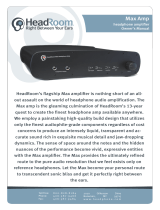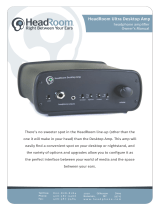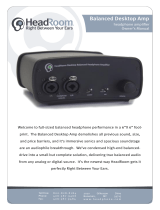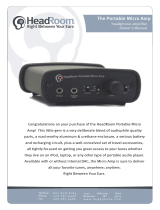Page is loading ...

1
Desktop Portable Amp
headphone amplifier
Owner’s Manual
Toll Free: 8 0 0 - 8 2 8 - 8 1 8 4
Phone: 4 0 6 - 5 8 7 - 9 4 6 6
Fax: 4 0 6 - 5 8 7 - 9 4 8 4
2020 Gilkerson Drive
Bozeman, MT 59715
w w w . h e a d p h o n e . c o m
Congratulations on your new Desktop Portable Amp. The amp you hold in
your hands is the latest in a thirteen year long quest to build the world’s fin-
est portable headphone amp. It’s equally comfortable in your big rig at home
or on the tray table in front of you at 30,000 feet; it will take a signal from a
$10,000 cd player or iPod, drive your high quality headphones with author-
ity, and coat the inside of your head with the vivid colors of your favorite mu-
sic. Add the DAC option and you’ll be able to feed you amp from any source
with either Toslink (optical) or coax digital output, or from a computer’s USB
connection. There aren’t many portables around these days that have digital
outs, but most of today’s portable DVD players play CDs and have digital
outs that operate under battery power. You’ll be amazed at the quality of
play by all the great musicians that show up in your head. And if you haven’t
tried playing movies with WinDVD with Dolby Headphone plug-in on your
laptop through a good digital amp, and boy, are you in for a real treat. Oh,
and don’t forget to check out the Desktop Portable DVD Bag on our web site.
It will conveniently carry the amp, battery pack, and portable DVD or other
player of choice.

2
3
The Desktop Portable Amp
2.
Headphone
Outputs
1.
Power
Switch
3.
Brightness
Switch
6.
Volume
Control
4.
Crossfeed
Switch
5.
Gain
Switch
1. Power Switch When using the battery pack the power switch will turn
your Desktop Amp on. The green LED will illuminute in the center of the Head-
Room logo in the upper left hand corner of the amp. When using the +/-15v
supply the amp is always on.
2. Headphone Ouputs The headphone out is where you plug in your
headphones. The Desktop Amp is equipped with a 1/4” jack as well as an
1/8” jack, to accomodate various types of headphones.
3. Brightness Switch The Brightness Switch is used to compensate for
the warming action of the processor. In the center position there is no filter in
the circuit; generally this is preferred. But if the processor is causing too much
bass or blurring of the central image, a mild high frequence boost filter can
be turned on. The “filter 1” setting accentuates the highs at about 3 kHz; with
the “filter 2” setting the filter starts an octave earlier and catches some of the
upper mids. Basically, set it to whatever sounds best to you.
4. Crossfeed Switch This switch engages the crossfeed circuit. Audio im-
aging on headphones is often not very good; typically the image is a blob on
the left, a blob on the right, and a blob in the middle. The HeadRoom cross-
feed provides the natural acoustic cross-feed normally heard at the left and
right ear as heard from the left and right speaker. Adding back the normally
occurring cross-feed signal gives your brain enough information to build the
stable and natural audio image needed to have a quality listening experience.
See pg. 7 for more info on the HeadRoom crossfeed.
5. Gain Switch The 3-position Gain Switch accomodates various head-
phones’ power needs. For instance, the Low Gain setting would be used for
in-ear monitors, allowing a larger range on the volume control pot. Experie-
menting with your headphones and the gain switch may help you to determine
which setting you prefer. If have any questions regarding your headphones,
feel free to call and ask us.
6. Volume Control You never know where the volume control should be set
as different headphones often have widely different impedances and efficien-
cies, so use your ears to choose your listening level, not the level on the dial.
(We recommend you choose a moderate level so as not to blow out your ears.)
You also need to turn the amp OFF or ALL THE WAY DOWN before plugging in or
unplugging your headphones to avoid a potential short-circuiting of the amp.
As you turn the volume control knob clockwise, the volume increases.
The Desktop Portable Amp Front Panel Front Panel Description

4
5
The Desktop Portable Amp Rear Panel
1.
RCA
Analog
Inputs
6.
7.
10.
9.
8.
4.
+/- 15
VDC
Power
Input
(DAC Option)
5.
Battery
input
2.
1/8”
Analog
input
3.
Power
Source
Selector
Rear Panel Description
1. RCA Analog Inputs There is one set of RCA inputs on the back of the
Desktop Portable Amp. The analog inputs are where you will plug in your non-
digital source, such as a stationary or portable CD player. If your player has
an 1/8” line out plug, you will use a portable cable (mini-RCA); if it has an RCA
out (left and right) then you will use a link interconnect (RCA -RCA). See the
‘cables’ area in our website to purchase some of these cables.
2. 1/8” Analog Input The 1/8” input is a typical line input connector. You
can connect your analog source by using a mini-mini cable from the line out
(or headphone jack) of your source into this connector.
3. Power Source Selector To the right is the power source switch, which
allows you to select battery power or external power to run your Desktop Por-
table Amp. The amp will run on either four D-cell batteries or an external power
supply. We offer two power supplies: the less expensive version, lovingly
known as “brick”, power supply comes with the amp, the more expensive
Desktop Power Supply will give you cleaner juice, and therefore cleaner, more
dynamic sound.
4. +/- 15VDC Power Input Plug in your power supply here. The ‘brick’
power supply included with the Desktop amp, as well as the Desktop Power
Supply, will use this connector. See pg 9 for more info on the Power Supply.
5. Battery Input Connect the battery pack included with your Desktop Por-
table Amp here. The red battery pack included with the unit takes 4 D-cell
batteries and provides about 20 hours of play time, with the basic Desktop
Portable. Upgrading the module or adding the DAC reduces playtime.
Desktop Amp Rear Panel
see page 6

6
7
What is the HeadRoom Crossfeed?
Imagine you are listening to a pair of speakers. If you turn off the left speaker,
both ears hear the sound from the right speaker. But because the left ear is
slight farther away than the right ear, it hears the speaker’s sound slightly
after the right ear; about 300 microSeconds. This time difference is called the
“inter-aural time difference” and it is the main thing your brain listens for in
order to tell where to place sound left-to-right.
But in headphones if you turn off the left channel, only the right ear hears the
sound. In headphones, if there is any sound that is only in the left channel, or
only in the right channel, then only that ear hears the sound. This is not natu-
ral, and you brain becomes fatigued trying to figure out where sound is com-
ing from when only one ear is hearing it. This tends to create an audio image
that is a blob on the left, blob on the right and a blob in the middle.
HeadRoom amplifiers cure the problem by allowing you to cross-feed a little
of the left and right channels across to each other through a short time de-
lay using the processor switch. The usefulness of the circuit varies depending
on what type of recording you are listening to; mono and binaural recordings
need no processor at all. Old studio recordings that have instruments panned
hard left or right, benefit greatly from the processor. Live and classical record-
ings miked from a distance benefit somewhat less, and can often be listened
to without the processor quite comfortably.
Plain
Headphones
With
HeadRoom
The crossfeed switch in Head-
Room amplifiers allow you to
cross-feed a little of the left and
right channels across to eacho-
ther through a short time delay.
The Digital-Analog Convertor Option
When purchasing the Desktop Portable Amp, you have the option of including
a DAC. If you did not purchase the DAC option with your amp initially, you can
have this upgrade performed at a later date.
The Desktop DAC is a clean, well-balanced, and natural sounding converter. It
uses the Cirrus Logic’s flagship CS4398 24bit/192kHz, 120dB dynamic range
digital to analog converter. Coupled with extensive power supply isolation
and regulation this DAC will take virtually any digital source and turn it into a
quality listening experience.
The Desktop DAC board uses the well regarded Burr-Brown 134 in single pack-
ages; only metal thin film resistors and polyphenylenesulfide (poly film) ca-
pacitors are used anywhere near the audio circuits. Three low-noise, ultra-
low dropout power supply regulators isolate the various digital, analog, and
mixed signal circuits.
9.
coaxial input
8. USB input
10.
optical input
7.
digital input
selector
6.
source selector
6. Source Selector When using the DAC, you will need to choose whether
you are using a digital input or an analog input. The source selector switch al-
lows you to have both digital and analog sources connected at the same time,
and you may change between the two with a simple flip of this switch.
7. Digital Input Selector When using the DAC, the digital input selector
allows you to choose which digital input you would like to listen to.
8. USB Input The USB input gets its signal from a computer: laptop or desk-
top; PC, Mac, or Unix.
9. Coaxial input The coaxial input is your typical coaxial connector. We
recommend using a 75 ohm digital cable when using the coaxial input.
10. Optical Input The optical input is your typical Toslink connector. You
get this input signal from the optical output of your player. Not so many por-
table audio players have optical outputs anymore (call or check our web site
for recommendations), but many portable DVD players and some hard disk
drive players do. Of course, you can get this signal from many pieces of home
equipment.
Far ear
hears
slight delay.
Near ear
hears
sound first.
30 degrees
off axis

8
9
All our amps come with a surprisingly good,
but still inexpensive, power supply. Any au-
diophile will tell you that the power supply
is as, or almost as important as the audio
electronics themselves. This is true. While
we think the other upgrades available for
the amps may be slightly more important,
the Desktop Supply will get every last drop
of performance out of the amp you buy.Maximum current output before a potential
loss in audio quality is 500 mA. For the best performance, we recommend one dedi-
cated DPS for each headphone amp.
1. Ground Lift The Ground Lift seperates the audio signal ground from the power
supply ground. Usually, you will want the Ground Lift Switch to be set to ‘normal’, but
if you hear a slight buzzing noise in your system, then turn the Ground Lift Switch to
‘float’.
2. Power Entry Module The Power Entry Module is where the Power Supply is
plugged into the wall. The power entry module can also be easily changed into other
common international voltages. Using a coin or screw driver, open the module on
the right side, and turn the voltage indicator around to read the appropriate voltage
for your region. The red window box on the power entry module indicates the current
voltage setting of your amplifier. You can easily switch the voltage between 115 VAC
and 230 VAC by carefully opening the power receptacle window housing, then simply
slide out the receptacle and reinsert it facing the opposite way until the desired voltage
clearly shows through the power module window box. The whole process should take
less than a minute!
3. Power Outputs There are 6 power outputs on the Desktop Power Supply, and
is appropriate for use with any of the HeadRoom Desktop or Micro Lines of amps and
DACs.
Desktop Electronics Module
This little green module contains all the electronics for a Desktop Headphone Amp.
There are two 4-layer circuit boards (one each for the left and right channel) that are
connected with a series of header pins used to solder the module to the main circuit
board. This module is designed to sound great but must provide at least 20 hours of
play time on four D-cells in the Desktop Portable Amp. It uses Burr-Brown (Okay, now
TI) 2134 op-amps for the internal input buffer, crossfeed, summer, and power amp volt-
age gain stage. The output current amplifier is our version of the highly regarded Dia-
mond Buffer discrete transistor design by Walt Jung. Resistors are 1% metal thin film,
and caps in the signal chain are polyphenylenesulfide (poly film); these are MUCH
higher quality parts than you’d ever find in a typical consumer electronics product.
The Desktop portable can be upgraded to the Home module, but it will cut battery very
significantly and we don’t recommend it.
How to Connect Your Desktop Portable Amp
Electronics Module; Power Supply Upgrade
Desktop Power Supply Upgrade
1.
ground
lift
switch
3.
Power Outputs
To an Analog Source
You will need a portable cable or RCA interconnect to connect your analog
source to the Desktop Portable Amp. Plug the RCA inputs into the back of the
Desktop Portable Amp with the other end connected to the line output of your
analog source (or a headphone jack if there is no line out available.) Don’t
forget to select the appropriate input with the Source Selector Switch.
Shown to the left is a
portable CD player, us-
ing the line out of the CD
player to the analog in-
put of the Desktop Por-
table Amp.
Portable CD Player
To a Digital Source (DAC Option)
Your digital source will have either the USB, coaxial, or optical outputs. Plug
the appropriate cable into the corresponding digital input on the back of the
Desktop Portable Amp. Be sure to select ‘digital’ on the Source Selector
Switch, and the correct digital input with the
Digital Input Selector
Switch.
Most new hard-drive MP3
players on the market no lon-
ger have digital outputs, but
many existing HD players do.
This iRiver player below uses
an optical line-out, into the
optical input of the Desktop
DAC.
Portable DVD Player
The DVD player shown above uses
the optical input on the back of the
Desktop Portable Amp.
Hard-Drive MP3 Player
Desktop Power Supply
To the Desktop Power Supply
The Desktop Power Supply is a power supply
upgrade available for purchase on our web-
site. To connect the Desktop Power Supply,
you will need a power cable with 6 pin ter-
minations on either side. Connect the 5VDC
power input on the Desktop Portable Amp to
the one of the power inputs on the back of the
Desktop Power Supply. To learn more about
the Desktop Power Supply, see our section
on upgrades on the following page.
Power Entry
Module
2.

10
11
30 Day Guaranty & Warranty Info
Exchanges & Returns
HeadRoom 30 Day Guaranty
Unless specifically stated otherwise, all HeadRoom purchases come with a
30-day satisfaction guaranty in order to give you the opportunity to evaluate
your purchases. We’re happy to provide you with the opportunity to refund or
exchange your product, but to keep costs down we do have a few conditions.
Products must be returned to us within 30 days of the date you receive the
product. So make sure you try your purchase out right away! Products must be
in “as-new” condition. This means that they’re in pristine cosmetic condition,
functioning perfectly, and include ALL materials (plastic bags, warranty cards,
tie wraps, etc). In other words, please send products back exactly as you re-
ceived them. If a product is returned within the 30-day return period, but is not
in “as-new” condition, we will charge you a 15% restocking fee plus any labor
and materials required to return the product to “as-new” condition. Sorry, but
after your 30 day trial, products are no longer exchangeable or refundable.
If you’re having trouble with a headphone amp or system, please contact us
first to troubleshoot the problem. You can email Sales, (sales@headphone.
com) or call 800.828.8184. If we can fix it while you’ve still got the product,
everyone’s happy!
Desktop Portable Amp Warranty
The HeadRoom Desktop Portable Amp is warrantied for two years. If anytime
within the first two years of your purchase you have a problem with your amp,
you can return it for repairs under the terms of our warranty.
HeadRoom is the only authorized service center for HeadRoom products, ei-
ther in or out of warranty. If a unit is under warranty, there is no cost for the
repair labor, parts, or shipping from HeadRoom back to you (i.e., You’re re-
sponsible for paying the shipping charges to get the product to us).
Out of Warranty Repairs
Non warranty repairs are assessed at an hourly rate of $50 per hour plus parts,
and are only conducted on HeadRoom products. If the cost of the repair is
over $100, we will call you with an estimate. If you have an older HeadRoom
amp that is out of production, we may not be able to repair the amp, however
please contact us and we will let you know if we are able to. When we receive
the equipment, we will initiate repairs and upgrades within 1-2 weeks and
return the unit to you. The customer pays for shipping to HeadRoom and we
pay for return shipping. Please refer servicing to HeadRoom factory authorized
personnel as HeadRoom is the only authorized service center for HeadRoom
products, either in or out of warranty. Tampering by persons other than Head-
Room factory authorized personnel is discouraged and will void your warranty.
HeadRoom will not accept warranty claims for damage resulting from accident,
misuse, neglect, abuse or failure to follow instructions of operation.
Equipment Exchanges
If you would like to exchange your purchase for another item, you have two
options. You can simply purchase the item you want, and send the item you
don’t want back for refund within 30 days of the original purchase (don’t for-
get to fill out the back of the Return & Exchange card and include it with your
return). We will refund your credit card after we receive the item. Or, you can
send your product back as an exchange, and indicate the product you would
like on the Return card. We will adjust your credit card accordingly and ship
you the new item. Replacement products are shipped to you as soon as pos-
sible, typically within 3-5 days provided the replacement item is in stock.
Defective Equipment Exchanges
In the uncommon event of receiving a defective product, contact us and we
will ship out a replacement product to you at no cost as soon as possible,
typically within 3-5 days provided the replacement item is in stock. You will
receive the replacement item along with a return shipping label and a card to
include with the defective item to return to HeadRoom. Important: Fill in your
name and original invoice number of your order on the card and return the
item to HeadRoom within 2 weeks. If we have not received the product after 2
weeks (allowing shipping time) we will charge your credit card the amount of
the defective item. Please understand that we enforce this policy as an incen-
tive for customers to get defective equipment back to us as soon as possible.
Shipping Products back to HeadRoom
Please ship products back in the original shipping box (or another that is com-
parable); please don’t send headphones back in JUST the headphone box,
as it’s a sure bet that they will no longer be in “as-new” condition when we
receive them! We HIGHLY recommend that you ship returns using an insured
and “signature required” delivery method—we can’t be responsible for lost or
damaged packages. Finally, don’t forget to include the completed Return &
Exchange card and WRITE YOUR NAME on the outside of the box!
Return Products to:
HeadRoom
Attn: Returns
2020 Gilkerson Drive
Bozeman, MT 59715
Contact Us:
www.headphone.com
Toll Free: 800-828-8184
Phone: 406-587-9466
Fax: 406-586-9484

12
Toll Free: 8 0 0 - 8 2 8 - 8 1 8 4
Phone: 4 0 6 - 5 8 7 - 9 4 6 6
Fax: 4 0 6 - 5 8 7 - 9 4 8 4
2020 Gilkerson Drive
Bozeman, MT 59715
w w w . h e a d p h o n e . c o m
Contacting HeadRoom
A Word About Your Hearing
People have a natural tendency to listen to music at much louder levels with
headphones than they would with speakers. To avoid permanent hearing
damage, it’s important to be careful not to listen at extremely loud levels (or
to listen for too long at moderately loud levels). Because HeadRoom amps
need to be able to drive even the most inefficient dynamic headphones to sat-
isfactory listening levels, they are also able to drive headphones of average
or higher efficiencies to extremely high levels. As a result, even though the
volume control on your HeadRoom amp may appear to be set to a low level,
you may not be listening at a safe level. Generally speaking, when listening
to headphones you should only turn up the volume to the point at which the
sound isn’t too quiet.
As a general rule, sound pressure levels under 80 decibels will not damage
hearing, even if experienced continually. On the other hand, anything over
100 decibels may cause permanent damage very quickly. Sustained exposure
to sound pressure levels anywhere in between can also be damaging —the
louder the sound, the shorter the time required to cause permanent damage.
Just to drive this message home, here’s a bit of information about hearing
damage. The most common type of damage caused by prolonged or exces-
sively loud sound is called tinnitus. It manifests itself as a sustained buzzing
and/or ringing in the ears, and can become a permanent condition.
If you find that your ears are ringing or that there is a sensation of pressure or
fatigue, your body is trying to tell you that your ears need a break. Give them
a rest for a few days (or until they feel fresh). If you ignore these symptoms,
you’re risking permanent hearing damage.
In addition, don’t fool yourself into thinking that you either have full-blown
tinnitus or you don’t have it at all—there are different degrees of hearing dam-
age. For example, you might have a mild case where you only notice ringing
in your ears in the quiet of your bedroom at night. However, once you have a
slight case of tinnitus, your ears are much more susceptible to further dam-
age. So if you do experience mild symptoms, it’s important to be much more
careful about your exposure to loud sounds.
Sorry to sound so sobering, but a lifetime of musical enjoyment requires ears
in tiptop shape. Now that we’ve told you to be careful, don’t blame us if you
blow it. If you have any more questions about hearing damage, call a doctor.
/












